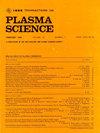Design of an Oppositely-Oriented Circular Split-Ring Resonator-Loaded Multibeam All-Metallic Metamaterial Backward-Wave Oscillator
IF 1.3
4区 物理与天体物理
Q3 PHYSICS, FLUIDS & PLASMAS
引用次数: 0
Abstract
In this article, we proposed a novel metamaterial (MTM) inspired interaction structure for high-power microwave backward-wave oscillator (BWO). The proposed structure is an all-metallic MTM slow wave structure (MSWS) which comprises of a number of broadside-coupled split ring resonator (BC-SRR) pairs, arranged periodically in the axial direction and repeated azimuthally. Each pair of oppositely oriented split ring resonator (SRR) provides negative $\mu$ and the cylindrical waveguide generates negative $\varepsilon$ medium for below cutoff TE-modes propagation. The full wave cold simulation analysis of the proposed structure, using computer simulation technique (CST)-microwave studio, has been carried out with the objectives of double-negative medium (DNM) optimization, dispersion, and interaction characterization, and S-parameter validation. For the particle-in-cell (PIC) simulation analysis, the CST-particle studio (CST-PS) has been used. In this work, we report an operation of the proposed MTM-loaded BWO (MTM-BWO) employing a beam potential and total beam current of 340 kV and 1.2 kA, respectively, generating an output power of 175 MW within 22–24 ns with an efficiency of 43% using the four-beam MSWS. As compared to its three-beam counterpart, the four-beam structure generates higher power with better efficiency.反向圆分裂环谐振腔加载多波束全金属超材料后向波振荡器的设计
在本文中,我们提出了一种新的超材料(MTM)启发的高功率微波后向波振荡器(BWO)相互作用结构。所提出的结构是全金属MTM慢波结构(MSWS),其包括多个宽侧耦合开口环谐振器(BC-SRR)对,在轴向方向上周期性地布置并在方位角上重复。每对定向相反的开口环谐振器(SRR)提供负$\mu$,并且圆柱形波导产生用于低于截止TE模式传播的负$\varepsilon$介质。利用计算机模拟技术(CST)-微波工作室对所提出的结构进行了全波冷模拟分析,目的是对双负介质(DNM)进行优化、色散和相互作用表征以及S参数验证。对于细胞内粒子(PIC)模拟分析,使用了CST粒子工作室(CST-PS)。在这项工作中,我们报告了所提出的MTM负载BWO(MTM-BWO)的操作,其使用的束电位和总束电流分别为340 kV和1.2 kA,使用四束MSWS在22-24 ns内产生175 MW的输出功率,效率为43%。与三梁结构相比,四梁结构产生更高的功率和更好的效率。
本文章由计算机程序翻译,如有差异,请以英文原文为准。
求助全文
约1分钟内获得全文
求助全文
来源期刊

IEEE Transactions on Plasma Science
物理-物理:流体与等离子体
CiteScore
3.00
自引率
20.00%
发文量
538
审稿时长
3.8 months
期刊介绍:
The scope covers all aspects of the theory and application of plasma science. It includes the following areas: magnetohydrodynamics; thermionics and plasma diodes; basic plasma phenomena; gaseous electronics; microwave/plasma interaction; electron, ion, and plasma sources; space plasmas; intense electron and ion beams; laser-plasma interactions; plasma diagnostics; plasma chemistry and processing; solid-state plasmas; plasma heating; plasma for controlled fusion research; high energy density plasmas; industrial/commercial applications of plasma physics; plasma waves and instabilities; and high power microwave and submillimeter wave generation.
 求助内容:
求助内容: 应助结果提醒方式:
应助结果提醒方式:


